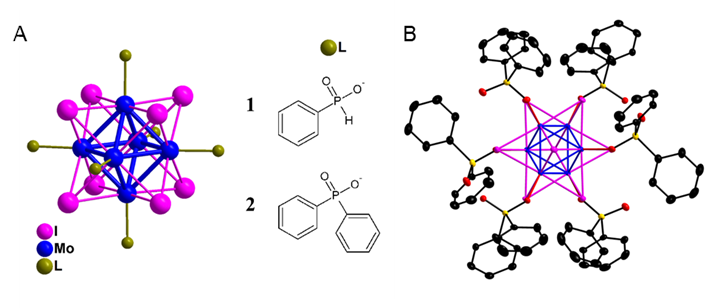Phosphinate Ligands: A Route to Photoactive Biomaterials for Photodynamic Applications
Kaplan Kirakci,¹ Jan Demel,¹ Jan Hynek,¹ Jaroslav Zelenka,² Michaela Rumlová,² Tomáš Ruml,² and Kamil Lang¹*
Institute of Inorganic Chemistry of the Czech Academy of Sciences, Řež 1001, 250 68 Husinec-Řež, Czech Republic
University of Chemistry and Technology Prague, Technická 5, 166 28 Praha 6, Czech Republic
Recent studies have unraveled the potential of octahedral molybdenum cluster complexes (Mo6) as relevant red phosphors and photosensitizers of singlet oxygen, O₂(¹Δᵍ), for photobiological applications. However, these complexes tend to hydrolyze in aqueous environment, which deteriorates their properties and limits their applications. To address this issue, we show that phenylphosphinates are extraordinary apical ligands for the construction of Mo6 complexes. These new complexes display unmatched luminescence quantum yields and singlet oxygen production in aqueous solutions. More importantly, the complex with diphenylphosphinate ligands is the only stable complex of this type in aqueous media. These complexes internalize in lysosomes of HeLa cells, have no dark toxicity, and yet are phototoxic in the sub-micromolar concentration range. The superior hydrolytic stability of the diphenylphosphinate complex allows for a conservation of its photophysical properties and biological activity over a long period, making it a promising compound for photobiological applications.

A) Schematic representation of the molecular structures. B) Crystallographic representation of the determined molecular structure of 2 (blue: molybdenum, purple: iodine, yellow: phosphorous, red: oxygen, black: carbon, hydrogen atoms are omitted for clarity).
